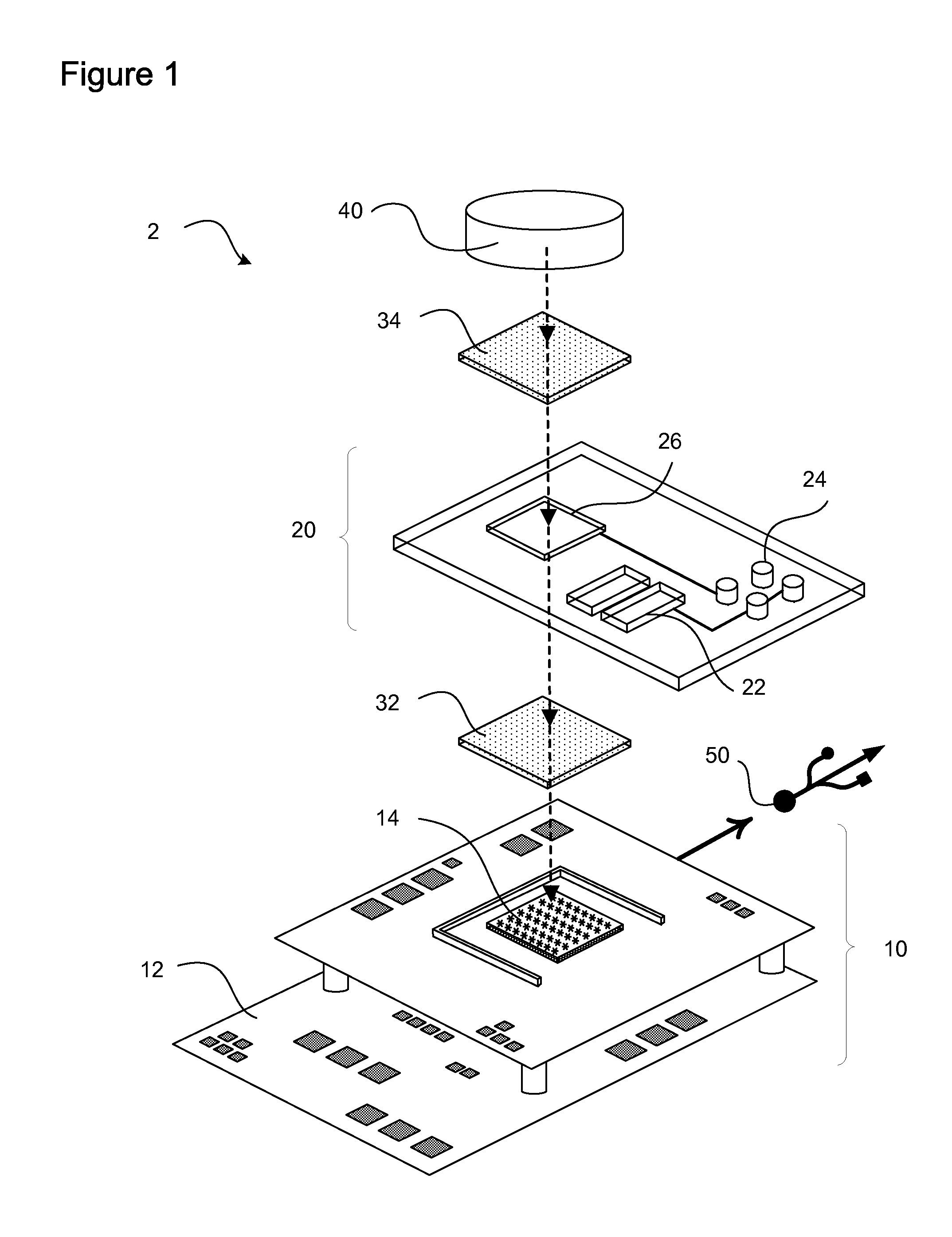Method and apparatus for quantitative microimaging
a micro-imaging and quantitative technology, applied in the field of labonachip type imaging and assays, can solve the problems of limiting the application of optical analysis methods to truly portable total analysis systems and methods, affecting and limiting the application of optical analysis methods. , to achieve the effect of facilitating micro-operation and simplifying the design of cytometers
- Summary
- Abstract
- Description
- Claims
- Application Information
AI Technical Summary
Benefits of technology
Problems solved by technology
Method used
Image
Examples
example 1
Initial Proof of Principal Studies
[0060]Reagents were imaged in the digital microfluidic device depicted in FIGS. 2a-d including a CMOS image sensor integrated with digital microfluidics. FIG. 2a is a top view, while FIG. 2d is a side view. Scale bars of 5 mm are shown on FIGS. 2a and d. FIG. 2b provides a magnified view of the CMOS image sensor overlayed by a dielectrophoresis (DEP) fluid handling electrode array. The scale bar is 1 mm. The DEP microfluidic device utilizes electrically generated forces to manipulate discrete reagent droplets. The reagents are not confined to channels but are instead manipulated using an addressable electrode array.
[0061]The fluid handling microelectrode array was fabricated using standard microlithographic wet etch processing from thin film Au / Ti (2500 Å / 500 Å) on 1 mm-thick Pyrex substrates. The upper fluidics layer was laser-machined in-house (VersaLASER, Universal Laser Systems, Inc., Scottsdale, Ariz.) from a cast acrylic sheet (Acrylite G P, E...
example 2
Cell Quantitation
[0072]In one embodiment of the invention, apparatus and methods are provided for quantitation of relative cell populations in a mixed cell population. In ordinary manual cell counting assays using Neubauer haemocytometers, cells are loaded into a fixed volume 3 mm×3 mm×0.1 mm chamber that contains 900 nL of cell suspension. Contact imaging such reservoirs is feasible as these dimensions are within the active area of typical digital image sensor formats, including a 1 / 3.6″ format which comprises a 4.00 mm×3.00 mm imaging area and is the smallest of the standard image sensor formats. In one embodiment, the sample preparation cartridge for the point-of-need image cytometer will include an integrated volume-calibrated reservoir similar to that found in a haemocytometer, enabling cell counts to be expressed in terms of concentration, an important consideration for diagnostic assays. In particular embodiments, all fluid handling is integral to the sample preparation cartr...
example 3
[0086]There are numerous examples in medicine where selection of a particular drug from the large class of drugs available to treat a particular condition is empirical. For any given drug, efficacy and side effects are essentially averaged over populations of treated patients while the activity of the drug in a given individual in unknown until it is administered. Often different drugs from a class must be serially administered to an individual until a particular drug from the class is identified that is both safe and efficacious in that individual. Individual drug actions cannot be translated from one individual to another. With certain drugs and in certain disease the empirical approach is dangerous and prolongs the period of uncontrolled disease. For example, selection of a safe and effective drug for an individual patient from powerful and potentially dangerous classes of drugs has heretofore been largely empirical. Such drug classes include anti-platelet dr...
PUM
 Login to View More
Login to View More Abstract
Description
Claims
Application Information
 Login to View More
Login to View More - R&D
- Intellectual Property
- Life Sciences
- Materials
- Tech Scout
- Unparalleled Data Quality
- Higher Quality Content
- 60% Fewer Hallucinations
Browse by: Latest US Patents, China's latest patents, Technical Efficacy Thesaurus, Application Domain, Technology Topic, Popular Technical Reports.
© 2025 PatSnap. All rights reserved.Legal|Privacy policy|Modern Slavery Act Transparency Statement|Sitemap|About US| Contact US: help@patsnap.com



